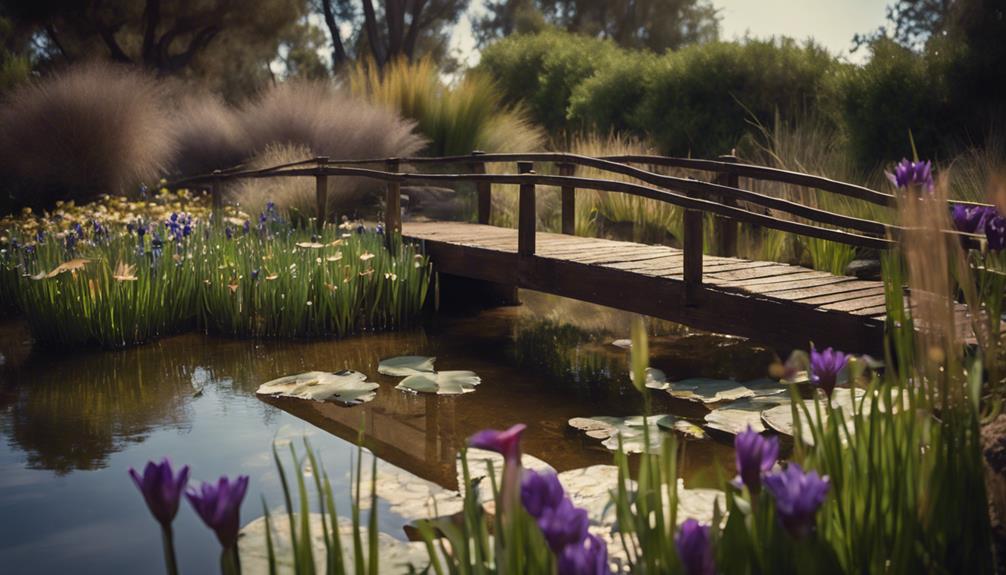You're looking for drought-tolerant aquatic plants that can thrive in low-maintenance gardens with limited water resources. These plants have adapted to survive in water features with low water flow or periods of drought, conserving water by storing it in their leaves or stems, producing small leaves, or developing deep roots. Popular options include water lilies, cattails, and irises that can thrive in shallow water or wet soil. They're ideal for gardens with limited water resources, as they conserve water, prevent soil erosion, and support biodiversity. Discover how to choose and maintain the perfect drought-tolerant aquatic plants for your water-efficient garden design.
Table of Contents
Key Takeaways
- Drought-tolerant aquatic plants conserve water by storing it in leaves or stems, producing small leaves, or developing deep roots to access groundwater.
- Popular drought-tolerant aquatic plants include water lilies, cattails, and irises that thrive in shallow water or wet soil with minimal watering.
- These plants have unique characteristics such as deep roots, small leaves, and waxy coatings to reduce transpiration and prevent water loss.
- Incorporating drought-tolerant aquatic plants into garden design provides benefits like improved soil health, enhanced biodiversity, and significant water conservation.
- When choosing drought-tolerant aquatic plants, select species native to low-rainfall regions, with low water requirements, and features that enable water conservation.
Understanding Drought-Tolerant Aquatics
When designing a low-maintenance garden, you'll want to understand that drought-tolerant aquatic plants have adapted to survive in water features with limited water flow or periods of drought, making them an ideal choice for your outdoor space.
These plants have evolved unique strategies to conserve water, such as storing water in their leaves or stems, producing small leaves to reduce transpiration, or developing deep roots to access groundwater.
This means they can survive with minimal watering, but may still require occasional watering to maintain their health and appearance.
As you explore the world of drought-tolerant aquatic plants, you'll find a variety of options to choose from, including popular species like water lilies, cattails, and irises.
These plants can thrive in shallow water or wet soil, making them perfect for gardens with limited water resources.
When selecting drought-tolerant aquatic plants, consider factors such as growth rate, mature size, and sun requirements to guarantee they're suitable for your garden's specific conditions.
Benefits of Low-Water Plants
By incorporating drought-tolerant aquatic plants into your garden design, you'll reap numerous benefits that extend beyond mere aesthetics, including improved soil health, enhanced biodiversity, and significant water conservation.
These plants use minimal water and prevent soil erosion, making them an ideal choice for water-conscious gardeners.
By supporting soil health, creating shade and cooling pockets, and protecting homes from weathering, drought-tolerant plants reduce the need for frequent maintenance.
They also play a pivotal role in regulating the ecosystem by filtering air, transpiring water into the atmosphere, and creating clouds.
Drought-tolerant plants provide habitats and food for wildlife, offering visual interest in a landscape while supporting biodiversity.
With their ability to thrive in low-water conditions, they're the best option for the future, ensuring beautiful gardens without straining precious water resources.
By choosing drought-tolerant plants, you'll not only create a stunning outdoor space but also contribute to a healthier environment.
Aquatic Plants for Dry Climates
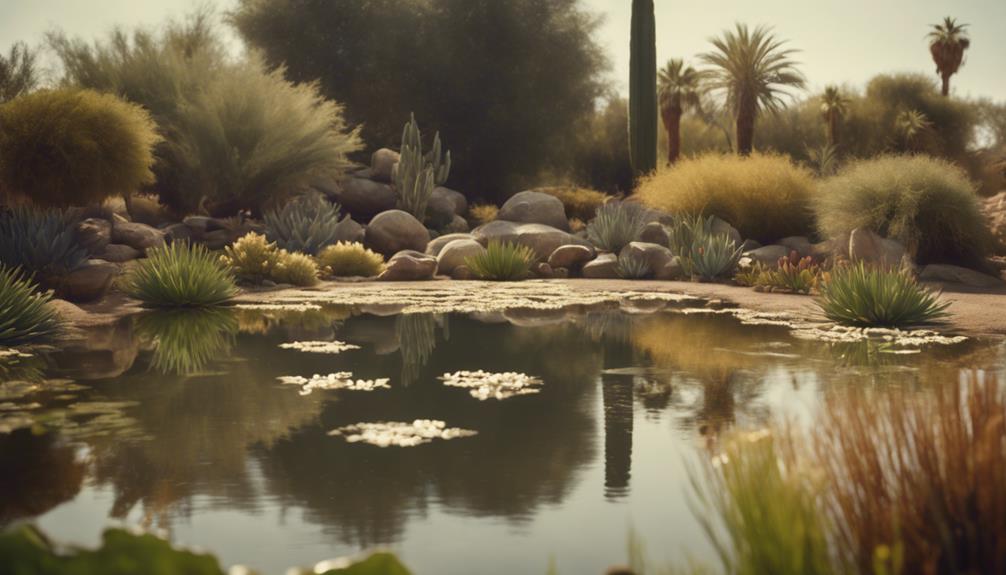
When designing a water feature for a dry climate, you'll want to focus on water conservation methods that minimize evaporation and maximize efficiency.
One effective approach is to incorporate native aquatic species that are adapted to thrive in local conditions, reducing the need for supplemental water and care.
Water Conservation Methods
In dry climates, incorporating drought-tolerant aquatic plants into your garden design can be a highly effective water conservation method.
By doing so, you can reduce water usage by up to 50% compared to traditional lawns and gardens.
This is especially true when using aquatic plants that can thrive in shallow water, such as water lilies and cattails, which require minimal maintenance.
In addition to reducing water usage, these plants can also help conserve water by tolerating high salinity levels, reducing the need for fertilizers and pesticides.
You can take it a step further by implementing rainwater harvesting systems to irrigate your drought-tolerant aquatic plants, further reducing the demand on potable water sources.
Native Aquatic Species
You can further enhance your water conservation efforts by incorporating native aquatic species into your garden design, as these plants have adapted to thrive in dry climates with minimal water requirements.
Native aquatic species like cattails, water lilies, and sedges are well-suited for dry climates, having adapted to survive with minimal water and thriving in low-water conditions.
The California pipevine, a native aquatic plant, is an ideal choice for water-conscious gardeners, tolerating drought and requiring minimal maintenance.
You can also consider water-wise aquatic plants like hornwort and anacharis as alternatives to traditional aquatic plants, requiring less water and care while still providing aesthetic benefits.
The blue flag iris, a native aquatic species, is another popular choice for low-maintenance gardens, tolerating a range of water levels and being drought-tolerant.
Additionally, the dwarf papyrus is well-suited for dry climates, thriving in shallow water and requiring minimal maintenance.
Drought-Tolerant Plant Characteristics
Drought-tolerant aquatic plants have evolved unique characteristics that enable them to thrive in water-scarce environments, developing specialized traits to conserve water and survive prolonged periods of drought.
As you explore these plants, you'll notice they've adapted to survive in conditions with limited water availability.
Deep roots: They've developed deep roots to access groundwater, ensuring a steady supply of water even when surface water is scarce.
Water-saving features: They often have small leaves, waxy or hairy coatings, and other features that help reduce transpiration and prevent water loss.
Slower growth rates: These plants typically grow slower, allowing them to conserve energy and resources during periods of water scarcity.
Dormancy: Some drought-tolerant plants can enter dormancy to survive extended droughts, only to recover quickly when water becomes available again.
Choosing the Right Aquatic Plants
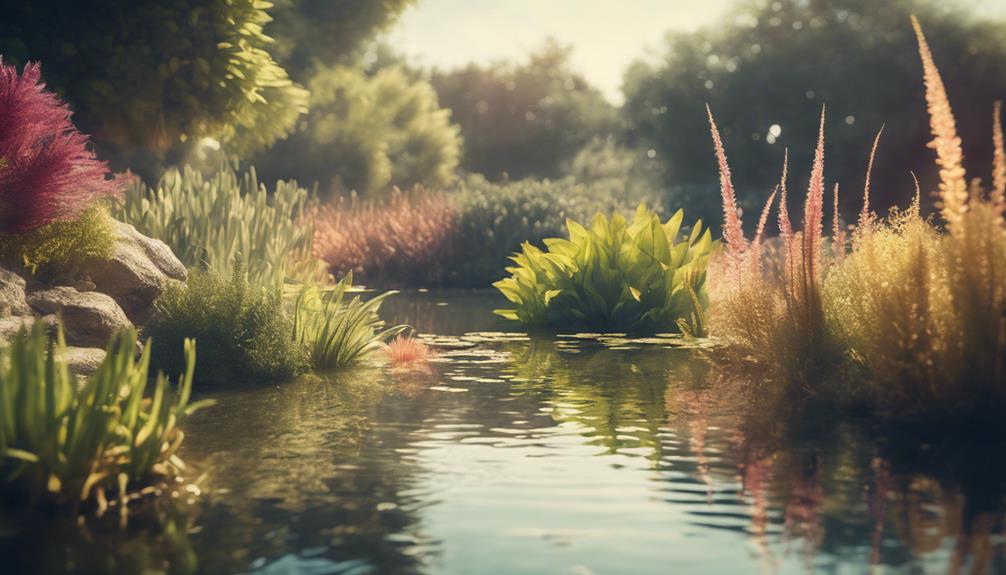
When choosing the right drought-tolerant aquatic plants for your specific needs, you'll want to ponder a few key factors.
You'll need to analyze the water requirements of each species, taking into account the water level, oxygen levels, and nutrient availability.
Aquatic Plant Selection
Selecting the right aquatic plants is crucial, as it can make all the difference in creating a thriving water feature that can withstand dry spells.
You want plants that can survive, even thrive, in conditions with limited water.
To do this, consider the following:
Native species: Choose plants native to regions with low rainfall, such as cattails, water lilies, and rushes. These plants have adapted to survive in water-scarce environments.
Water-conserving adaptations: Look for plants with deep roots, waxy leaves, or succulent stems that enable them to conserve water, like hornworts, spatterdocks, and bladderworts.
Drought-resistant spores or seeds: Plants like duckweed, watermeal, and azolla can tolerate drought by producing drought-resistant spores or seeds, allowing them to revive quickly when water becomes available.
Low water requirements: Plants like bog plants, such as pitcher plants, sundews, and bladderworts, are ideal for shallow water gardens or containers that may experience drought.
Water Requirements Analysis
By evaluating the water requirements of different aquatic plants, you can choose the right species for your specific water feature, guaranteeing a thriving ecosystem even in the face of drought. When selecting plants, consider the water depth and maintenance needs to certify a harmonious balance.
| Plant Type | Water Requirements |
|---|---|
| Submerged (e.g., anacharis, hornwort) | 1-10 ft, require little maintenance |
| Floating (e.g., water hyacinth, duckweed) | 1-4 ft, require little maintenance |
| Emergent (e.g., corkscrew rush, softstem bulrush) | 1-6 ft, require occasional watering and pruning |
Some plants, like water lilies and cattails, can thrive in shallow water with minimal maintenance. Others, such as horsetails and rushes, require moderate water levels and occasional watering. By understanding these needs, you can create a low-maintenance garden that requires little upkeep. This allows you to relax and enjoy your outdoor space, knowing that your aquatic plants are thriving despite the drought.
Maintenance Level Consideration
To guarantee a thriving aquatic ecosystem, you must ponder the maintenance level required by the plants you choose, as some species demand regular pruning, fertilization, or specific water conditions to flourish.
When selecting drought-tolerant aquatic plants, it's crucial to reflect on the time and effort you're willing to dedicate to their care.
Plants like Water Wisteria and Hornwort are ideal for busy gardeners, as they can survive with minimal care and still provide beautiful foliage.
Plants with low water requirements, such as Java Moss and Anacharis, are perfect for water-conscious gardeners who want to reduce their water usage.
Drought-tolerant aquatic plants like Anubias and Java Fern can survive out of water for short periods, making them ideal for gardens with fluctuating water levels.
When choosing aquatic plants, ponder the specific water conditions required, as some plants may need acidic or alkaline water to thrive, while others can adapt to a wide range of pH levels.
Creating a Water-Efficient Garden
One effective strategy for creating a water-efficient garden is to incorporate drought-tolerant aquatic plants, which not only minimize water usage but also provide a range of ecological benefits.
By choosing these plants, you'll reduce your water consumption and support soil health, creating a more sustainable garden.
In fact, xeriscaping, a type of landscaping that uses drought-tolerant plants, can reduce water consumption by up to 50% compared to traditional landscaping methods.
As you design your water-efficient garden, consider the benefits of drought-tolerant plants.
They prevent soil erosion, create shade and cooling pockets, and even protect your home from weathering.
Plus, in Western states, you may be eligible for water-wise rebate programs when you replace traditional lawns with drought-tolerant landscapes.
By incorporating drought-tolerant plants into your garden design, you'll not only reduce your water bill but also contribute to a more sustainable future.
With these plants, you'll create a beautiful, low-maintenance garden that's perfect for you and the environment.
Designing With Drought-Tolerant Plants
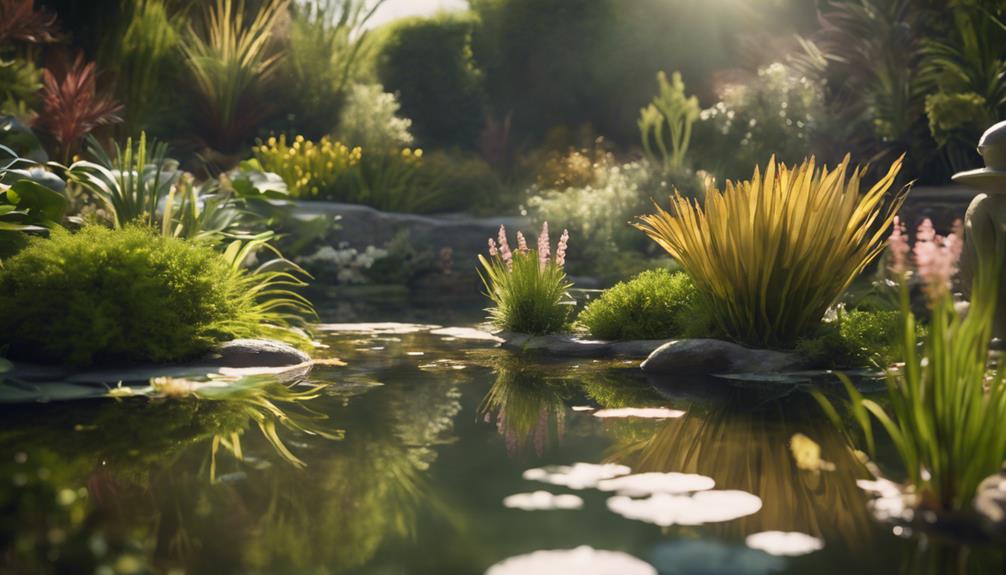
You'll need to thoughtfully plan your garden's layout to maximize the benefits of drought-tolerant plants, guaranteeing a beautiful, low-maintenance space that thrives in dry conditions. A well-designed landscape not only showcases these plants but also promotes water efficiency and reduces maintenance.
When designing your garden, consider the following key elements:
Plant spacing: Leave enough space between plants to prevent overcrowding and promote good air circulation, considering their mature size.
Water requirement grouping: Group plants by their water needs to guarantee each plant receives the right amount, reducing waste and overwatering.
Texture, color, and form variety: Incorporate a mix of textures, colors, and forms to add visual interest and create a dynamic, low-maintenance garden.
Layered landscape design: Combine tall plants, mid-sized shrubs, and low-growing ground covers to create a beautiful, layered landscape that thrives in dry conditions.
Plant Care and Maintenance Tips
By implementing a regular maintenance routine, you can guarantee the health and longevity of your drought-tolerant aquatic plants, even in water with a depth of just 1-6 inches. To keep your plants thriving, crucially necessary to clean your pond or water feature regularly and monitor water quality to prevent the buildup of toxins.
Task | Frequency |
| — | — |
|---|---|
| Clean the pond or water feature | Weekly |
| Monitor water quality | Bi-weekly |
| Fertilize | Monthly |
| Prune and divide | Quarterly |
Fertilizing your drought-tolerant aquatic plants can promote healthy growth and blooms, but be careful not to over-fertilize, as this can lead to algae growth and decreased water quality. Pruning and dividing your plants regularly can help control their spread, promote healthy growth, and encourage blooming. By following these simple maintenance tips, you can enjoy a beautiful and thriving low-maintenance garden that brings you joy and a sense of connection to nature.
Additional Resources for Gardeners
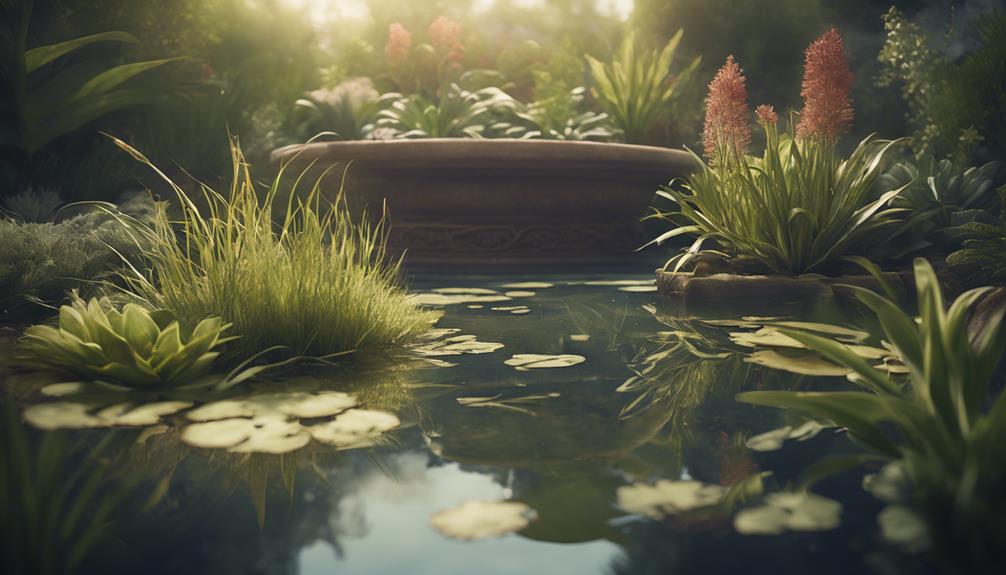
Beyond maintaining your drought-tolerant aquatic plants, exploring additional resources can further enhance your gardening expertise and provide valuable insights for creating a thriving low-maintenance garden.
You can expand your knowledge on water-efficient landscaping by visiting the Water Use Classification of Landscape Species (WUCOLS) Project website, which offers guidance on plants' irrigation water needs.
To take your gardening skills to the next level, consider the following resources:
Beth Chatto's book: Drought Resistant Planting, an exhaustive guide to drought-tolerant landscapes and plants.
Digging website: A treasure trove of real-life plant information, design insights, and how-to gardening tips, featuring beautiful plant photos and virtual garden tours.
California Water Service website: A valuable resource for water-conscious gardening, offering a list of low-water plants suitable for California's climate and information on water-saving practices.
High Country Gardens: A specialist in cultivars for sustainable gardens in the Intermountain West, providing expert advice on finding drought-tolerant plants suitable for specific regions and conditions.
Frequently Asked Questions
What Garden Plants Do Not Need a Lot of Water?
You'll find that succulents like Agave and Sedum, which store water in their leaves, stems, or roots, are perfect for you if you're looking for garden plants that don't need a lot of water.
What Is the Most Drought Tolerant Plant?
You're looking for the ultimate drought-tolerant champion! Among Succulent Superstars, the Desert Marigold takes the crown, thriving without water for up to 6 months and still blooming beautifully in full sun to partial shade.
What Are the Best Water Wise Plants?
You'll find the best water-wise plants for your water garden in Mediterranean-zone species like Lavender, Sage, and Russian Sage, which filter air, conserve water, and create a thriving ecosystem with minimal maintenance required.
What Is the Best Plant to Block Neighbors' Views?
You're looking for a privacy screen that's as impenetrable as a fortress wall. For a dense, view-blocking hedge, try the Firecracker Fern, growing up to 2-3 feet tall and wide, or the Evergreen Wisteria for a more formal, fragrant barrier.
Conclusion
Savor the serenity of a sustainable aquatic oasis, skillfully designed to thrive in dry conditions.
By selecting succulent species and strategizing water-wise practices, you'll be surrounded by stunning, stress-free scenery.
Cultivate a carefree haven that conserves vital resources, while enchanting your senses with vibrant, verdant beauty.

